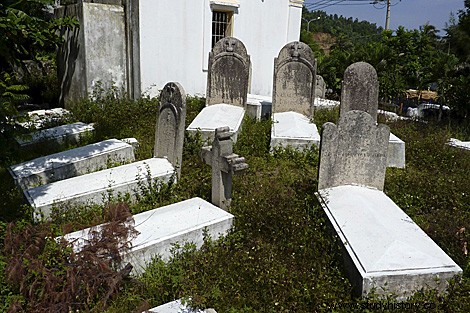It was the year 1857, specifically on July 20, when in Nam-Dinh , an enclave located north of present-day Vietnam, the Spanish missionary José María Díaz Sanjurjo , apostolic vicar of that region, was led to the scaffold loaded with chains. Minutes later, after two accurate blows from the executioner, the martyr's head was separated from his body. It was not an isolated event, but rather the straw that broke the camel's back. The persecution of Catholic missionaries in Indochina, especially in the Tonkin area , had been a constant for a long time.

A punitive expedition
Spain, then under the government of Isabel II, and with Leopoldo O'Donnell , president of the Council of Ministers, taking a good part of the transcendental decisions, receives the proposal from the France of Napoleon III :a punitive expedition had to be carried out. They had to make it clear that men who preached in the name of the Catholic faith could not be killed without consequences. The decision to accept the offer seemed rash. The Spanish coffers were in a very precarious situation, depleted by the Carlist wars and by the costs involved in maintaining an Empire that, even in its decline, generated a multitude of problems for the rulers:from the savage greed of the pirates, increasingly difficult to contain in the immense archipelago of the Philippines, even the incipient guerrilla movements of self-determination in Cuba. The dwarfs grew in the gardens of the Royal Palace of Madrid.

Without going into the everlasting internal problems of the country, it seems obvious that those responsible for the Spanish Government had many fronts to which they could dedicate their time, the money administered and the lives of the Spanish military. However, Spain was then a country proud of its glorious past, of which embers still remained. Like that nobleman who refuses to accept that, after decades of waste, the inheritance consists of little more than the noble title. In addition, we were still a territory in which any aroma of crusade continued to warm the spirits, even leaving aside the dictates of reason.
The Vietnam War:100 years before
About 100 years before the landing of US troops in Danang –in the central area of present-day Vietnam-, in the same place and also anticipating a quick campaign and an easy victory, Franco-Spanish troops arrived on land from Manila (Philippines). An expedition of about 1,500 men for each of the nations that had the mission of punishing the emperor Tu Duc , ruler of the Kingdom of Annam (present-day Vietnam), and cut the bleed against European missionaries. However, as would happen to the American troops decades later, they encountered much more difficulties than expected. The suffocating heat, the ardor of the annamites in defense of their territory and tropical diseases raged, except for the Tagalogs (native Filipinos) who joined the Spanish ranks.

Finally, after hundreds of casualties among the Spanish troops, the objectives were achieved. Saigon was conquered and a few years later, in 1862, a peace treaty was signed by which several Annamitic provinces They came under French control. Religious freedom for the French and Spanish also became a fact, at least on paper.
And for Spain…a park and a cemetery
France, as we have said, gained much more than religious freedom from her citizens in Indochina. That punitive expedition, turned into an occupation, opened up a very juicy commercial route for the neighboring country, which they thoroughly exploited in subsequent decades. In fact, the territories that Laos, Cambodia and Vietnam occupy today came to be under their control and the cultural influence was such that, even today, it can be seen in the aforementioned countries.
Spain, for its part, weighed down by the incompetence of its leaders, did not know how to take advantage of that expedition through Southeast Asia. The neighbors, in exchange for the Spanish collaboration that had brought them such huge benefits, barely ceded a small piece of land of about 4,000 square meters in the city of Saigon, which today is the Bach Tung Diep, park. an area much visited by tourists traveling to Vietnam. In 1922, abandoned and without any use, it returned to French hands.

A small 19th century Franco-Spanish cemetery, in which dozens of soldiers from both countries are buried, lies forgotten in Vietnam, near Danang , swallowed up by the growing industry of the surroundings. In one of its corners, deteriorated and eaten by weeds, you can find the tombs of 32 Spanish soldiers who died in the conquest of Vietnam, the ancient Annam kingdom, who were sent on an absurd mission by irresponsible leaders, but who, despite To this, they responded with courage and courage, to the point of giving their lives.
Collaboration of Alberto Gallego Ayuso
Sources:The Conchinchina War:when the Spanish conquered Vietnam – Luis Alejandre Síntes; Jose Maria Diaz Sanjurjo
